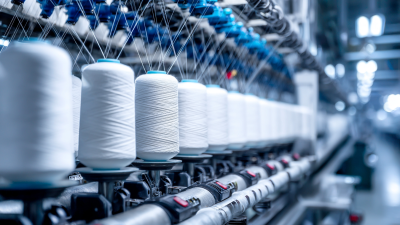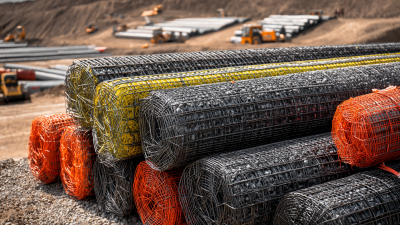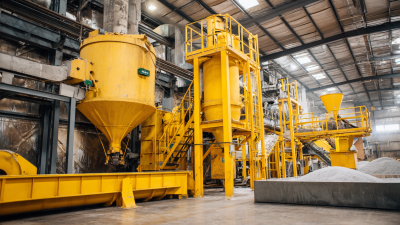7 Best Practices for Maximizing Efficiency with Raschel Warp Knitting Machines
Table of Contents
- Best Practices for Material Selection in Raschel Warp Knitting Machines
- Optimizing Machine Settings for Enhanced Production Efficiency
- The Role of Maintenance in Extending Machine Lifespan and Performance
- Leveraging Automation and Technology for Streamlined Operations
- Training Workforce on Advanced Techniques for Raschel Knitting Efficiency
- FAQS
- Conclusion
- Related Posts
Hey there! When it comes to textile manufacturing, staying efficient is pretty much the name of the game if you want to keep competitive and productive. Over at DANYANG YIXUN MACHINERY CO., LTD, we’re really proud of our expertise — especially when it comes to making advanced Raschel Warp Knitting Machines. These machines are a big deal because they help produce a super wide variety of fabrics, used in all sorts of applications — from glass fibers to everyday textiles. What’s awesome about the Raschel Warp Knitting Machine is its versatility and quick turnaround; it allows manufacturers to streamline their production and get more done in less time. In this blog, I want to share seven best practices that can really help you get the most out of your Raschel Warp Knitting Machines. By following these tips, your business can boost efficiency, improve operations, and of course, produce higher-quality output. Trust me, when you know how to unlock the full potential of your equipment, you’ll stay ahead of the curve in this fast-changing textile industry — no sweat!

Best Practices for Material Selection in Raschel Warp Knitting Machines
When it comes to getting the best out of Raschel warp knitting machines, choosing the right materials is a pretty big deal. The yarn you pick doesn’t just affect how the finished product looks—it also impacts its durability and how well it functions in real life. For instance, synthetic fibers like polyester and nylon are super popular because they’re strong, elastic, and resist wear and tear pretty effectively. That's why manufacturers love using them—they make lightweight fabrics that are surprisingly tough, perfect for everything from fashion to industrial stuff.
Plus, there are some other things to think about, like the yarn count and twist. Finer yarns can give you a softer, more delicate fabric, whereas fewer twists can help the fabric drape better and feel nicer to the touch. Mixing in blended fibers is also a clever move—it can boost moisture-wicking or thermal properties, depending on what you need. All in all, by paying attention to these details, manufacturers can really unlock the full potential of Raschel warp knitting machines and produce high-quality textiles that suit market needs pretty well.
Material Selection Efficiency in Raschel Warp Knitting Machines
Optimizing Machine Settings for Enhanced Production Efficiency
Tweaking the machine settings in Raschel warp knitting isn't just a technical detail—it's really how you can boost overall efficiency in textile manufacturing. I mean, according to the folks over at the International Textile Manufacturers Federation (ITMF), fine-tuning your settings can actually bump up production by about 15 to 20%. That's a pretty solid jump and can really make a difference for your bottom line. Things like adjusting warp tension, needle gauge, and feed rate might seem small, but they do a lot—they keep the machines running smoothly and cut down on wasted material.
 For example, if you keep the warp tension just right, you can avoid fabric defects. A report from the Textile Research Journal pointed out that those defects can cost manufacturers up to 5% of their annual budget—that’s no small potatoes.
For example, if you keep the warp tension just right, you can avoid fabric defects. A report from the Textile Research Journal pointed out that those defects can cost manufacturers up to 5% of their annual budget—that’s no small potatoes.
On top of that, dialing in your machine settings based on what kind of fabric you need can really step up the quality of your products. Precise needle adjustments, for instance, can improve stitch formation, which helps the fabric match the desired specs better—lowering rejection rates by as much as 10%. And nowadays, using data analytics to keep an eye on machine performance can help you find the best settings on the fly, making everything run more smoothly. All in all, paying attention to these main operational tweaks not only ramps up productivity but also ensures top-notch quality, giving manufacturers a real edge in such a competitive, ever-changing industry.
The Role of Maintenance in Extending Machine Lifespan and Performance
Keeping your Raschel warp knitting machines in good shape isn't just a good idea — it's pretty much essential if you want them to last and perform at their best. Regular preventive maintenance can really save the day by catching potential issues early on, before they turn into costly repairs. Make sure you stick to the manufacturer’s recommended routines, which usually involve cleaning, lubricating parts, and checking over key components. Honestly, following these steps might seem simple, but they make a huge difference.
One tip I swear by is keeping a maintenance log. Write down what you do, when you do it, and if you spot anything odd. It’s a real help for tracking the machine’s health over time and can give clues if something’s starting to go wrong. Also, investing some time in training your operators on proper handling and how to spot signs of wear and tear can be a game changer. When the team understands the importance of looking after the equipment, it becomes more of a shared responsibility to prevent breakdowns and avoid unnecessary headaches.
And don’t forget to keep spare parts handy. Having the needed components ready to go means less downtime and a smoother repair process. Overall, focusing on regular maintenance and making sure everyone’s in the know can really boost the lifespan and efficiency of your machines. It’s all about being proactive rather than reactive!
Leveraging Automation and Technology for Streamlined Operations
As the textile industry keeps leaning into automation and tech, getting the most out of Raschel warp knitting machines has really become a top priority for many manufacturers. If you’ve been following industry trends, you'd know that, according to a recent report from TechNavio, the global market for knitting machines is expected to grow at a compound annual rate of over 5% through 2025. This growth is mainly fueled by advances in automation, making things more efficient than ever. By bringing smart tech and automation into the mix, companies can streamline their processes, cut down on downtime, and boost productivity. That means they can keep up with the increasing demands of consumers while also keeping operational costs in check.

Here's a quick tip: investing in machine learning algorithms to optimize production schedules can work wonders. These automated systems analyze past output data to predict the best machine settings, which helps reduce waste and speeds up turnaround times.
And don’t overlook IoT solutions—they’re a game changer. With real-time data analytics, businesses can perform proactive maintenance, catching issues before they turn into costly breakdowns. In fact, a report from MarketsandMarkets points out that predictive maintenance could lower maintenance costs by as much as 30%. That means resources can be used more effectively.
Another tip—using cloud-based platforms can really improve teamwork. It allows everyone involved to access live data on machine performance and production metrics, enabling smarter decisions on the spot. So, overall, embracing these smart technologies isn’t just about staying current; it’s about making the whole process smoother, faster, and more cost-effective.
Training Workforce on Advanced Techniques for Raschel Knitting Efficiency
In today’s fast-moving world of textile manufacturing, getting the hang of advanced techniques for running Raschel warp knitting machines is pretty much essential if we want to bump up efficiency. Training your team in these skills isn’t just about improving their know-how; it really makes a difference when it comes to production results. I came across a report by Smithers Pira that suggests companies investing in ongoing training see productivity jumps of up to 30%. That just goes to show how crucial it is to set up solid, tailored training programs specifically for Raschel knitting work.
At DANYANG YIXUN MACHINERY CO., LTD, they truly believe that when workers are well-informed, they can operate multi-axial and biaxial warp knitting machines way more effectively. This means less downtime and better output overall. Plus, research indicates that properly trained operators make 25% fewer errors on their machines. The training isn’t just about the basics—it's also about understanding the finer points of stitch bonding and towel warp knitting used in glass fiber and textiles. By giving employees this kind of knowledge, companies stand to produce higher quality work, stay consistent, and stay ahead of the competition in the market.
7 Best Practices for Maximizing Efficiency with Raschel Warp Knitting Machines
| Practice | Description | Expected Efficiency Gain (%) | Training Frequency |
|---|---|---|---|
| Regular Maintenance | Conduct scheduled checks and repairs on machines. | 15% | Monthly |
| Operator Training | Train operators on advanced Raschel techniques. | 20% | Quarterly |
| Process Optimization | Review and streamline operational procedures. | 10% | Bi-Annually |
| Material Quality Control | Inspect yarn quality before production. | 12% | Every Batch |
| Data Monitoring | Utilize software for real-time machine performance tracking. | 18% | Continuous |
| Efficient Layout | Design factory layout for optimal workflow. | 14% | Annually |
| Team Communication | Encourage feedback and collaboration among staff. | 10% | Weekly |
FAQS
: Material selection is crucial because it influences the final product's appearance, durability, and functionality. Selecting the right yarn can enhance the performance of the knitted fabric.
Synthetic fibers like polyester and nylon are widely favored due to their strength, elasticity, and resistance to wear and tear, allowing for the creation of lightweight and robust fabrics.
Higher yarn counts can produce finer fabrics, while a lower twist can enhance the fabric's drape and softness, impacting the overall quality of the knit.
Automation maximizes efficiency by streamlining processes, reducing downtime, enhancing productivity, and allowing manufacturers to meet consumer demands while minimizing operational costs.
IoT solutions enable real-time data analytics, essential for proactive maintenance, which can lead to reduced unexpected breakdowns and maintenance costs.
Investing in workforce training significantly impacts production outcomes, as well-trained employees can operate machines more effectively, reducing error rates and boosting productivity.
Companies that invest in proper training can see productivity increases of up to 30% and a drop in error rates during machine operation by over 25%.
Machine learning algorithms can optimize production schedules by analyzing previous outputs, leading to reduced waste and improved turnaround times.
Utilizing cloud-based platforms for collaboration ensures all stakeholders have access to real-time information about machine performance and production metrics, facilitating better decision-making.
Incorporating blended fibers can enhance the overall qualities of the knit, improving attributes like moisture management and thermal regulation based on the intended use.
Conclusion
Getting the most out of Raschel Warp Knitting Machines really comes down to a few key practices that can seriously boost your production results. First off, picking the right materials is a big deal—using top-quality fibers that suit your specific needs can make a huge difference in how your final product performs. On top of that, tweaking your machine settings so everything runs smoothly is super important—it helps cut down on waste and gets more done in less time.
Don’t forget, regular maintenance is the secret to keeping these machines running for the long haul. Keeping up with routine checks and care can prevent unexpected breakdowns and keep things running smoothly. Also, taking advantage of automation and new tech can really help streamline your workflow—less manual fuss, more consistency. And honestly, investing in proper training for your team on the latest Raschel knitting techniques makes all the difference. Well-trained operators are more efficient and produce better quality products, which is a win all around.
Here at DANYANG YIXUN MACHINERY CO., LTD, we’re all about supporting these good practices by providing top-notch Raschel Warp Knitting Machines. We want you to succeed and make your production a whole lot easier and better!
Related Posts
-

How to Maximize Efficiency with Weft-Insertion Warp Knitting Machines in Textile Production
-

The Ultimate Guide to Understanding Geogrid Material for Construction Success
-

Understanding Biaxial Cloth: An Insight into Its Types and Applications
-

How to Optimize Your Production Line Efficiency with a Multifunction Batching Device
-

15 Best Polyester Geogrid Insights for Global Buyers
-

7 Essential Tips for Choosing the Right Industrial Fabric for Your Projects

